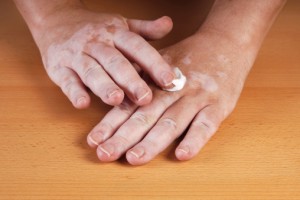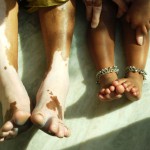


Vitiligo is a skin condition that leads to light and dark patches of skin discoloration. Although vitiligo commonly affects the skin, it can affect any area that has pigment, for example, a person can develop patches of white hair.
Vitiligo is not a contagious condition, nor is it life-threatening, but it can definitely alter a person’s life. Depending on where the skin is discolored it may affect a person’s self-esteem, for example, if it covers their face or other noticeable areas. Individuals may not want to go where there are large groups of people and they may even develop depression because of it.
When melanin-forming cells begin to die it causes vitiligo. Melanin is what gives skin, hair and even eyes their color, so when the cells stop producing pigment it creates light patches or no pigment.
Although it is not completely understood why these cells die, there are a few theories.
The primary symptom of vitiligo is discoloration of a pigmented area of the body – skin, hair or eyes. Other signs of vitiligo include:
 Skin discoloration
Skin discolorationVitiligo can appear just about anywhere on the body, but the type you have can determine which areas are affected. Some types of vitiligo occur all over the body (generalized), some are just on one side of the body (segmental) and others only appears on select areas of the body (focal).
Common treatments for vitiligo include:
This past year researchers also developed a unique way to treat vitiligo by transplanting pigment cells in order to repair the affected area. Dr. Amit Pandya developed this new technique, which is less painful than conventional treatment and involves harvesting cells from a blister and transferring them to the area that is missing pigment.
Dr. Pandya said, “This provides new hope for patients with vitiligo. The unique aspect of our procedure, which no one else in the world is doing, is the formation of blisters as the source of donor cells combined with laser surgery to prepare the grafted areas. The older method of cutting the skin leaves a scar. It doesn’t even hurt. It feels like something is sucking on your skin. Then using heat lamps we’re able to form blisters about the size of a dime.”
Aside from medical intervention, there are important at-home natural remedies to consider as well in order to protect your skin from damage. Home treatment for vitiligo involves:
Diet plays an important role in preventing vitiligo, see the vitiligo diet chart and foods to eat and avoid.
Copyright © www.orthopaedics.win Bone Health All Rights Reserved